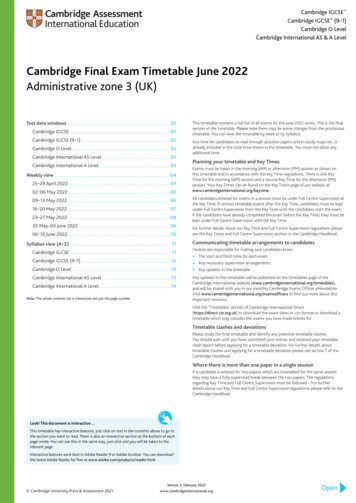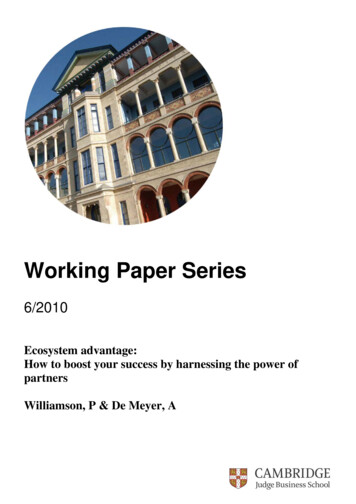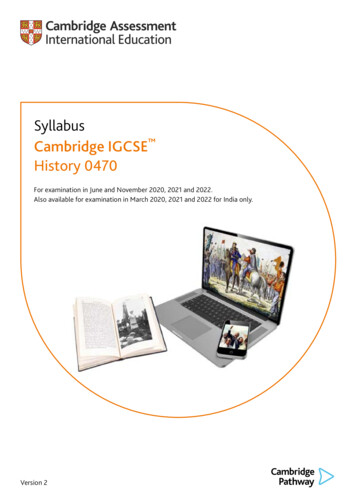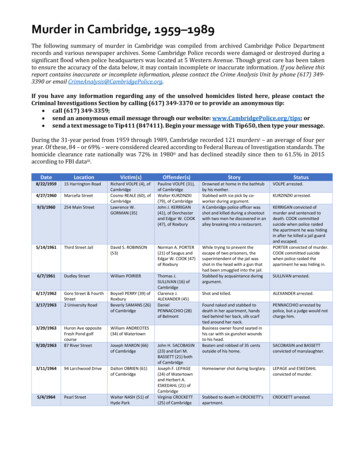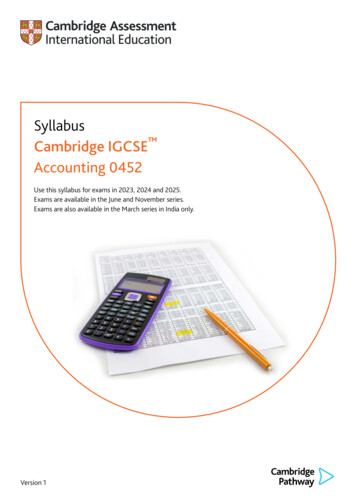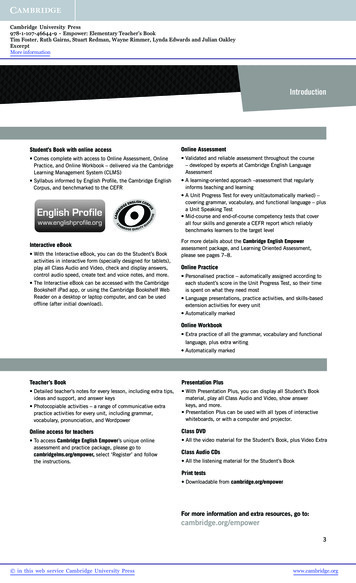
Transcription
Cambridge University Press978-1-107-46644-9 - Empower: Elementary Teacher’s BookTim Foster, Ruth Gairns, Stuart Redman, Wayne Rimmer, Lynda Edwards and Julian OakleyExcerptMore informationIntroductionStudent’s Book with online accessOnline Assessment Comes complete with access to Online Assessment, OnlinePractice, and Online Workbook – delivered via the CambridgeLearning Management System (CLMS) Validated and reliable assessment throughout the course– developed by experts at Cambridge English LanguageAssessment Syllabus informed by English Profile, the Cambridge EnglishCorpus, and benchmarked to the CEFR A learning-oriented approach –assessment that regularlyinforms teaching and learning A Unit Progress Test for every unit(automatically marked) –covering grammar, vocabulary, and functional language – plusa Unit Speaking Test Mid-course and end-of-course competency tests that coverall four skills and generate a CEFR report which reliablybenchmarks learners to the target levelInteractive eBook With the Interactive eBook, you can do the Student’s Bookactivities in interactive form (specially designed for tablets),play all Class Audio and Video, check and display answers,control audio speed, create text and voice notes, and more. The Interactive eBook can be accessed with the CambridgeBookshelf iPad app, or using the Cambridge Bookshelf WebReader on a desktop or laptop computer, and can be usedoffline (after initial download).For more details about the Cambridge English Empowerassessment package, and Learning Oriented Assessment,please see pages 7–8.Online Practice Personalised practice – automatically assigned according toeach student’s score in the Unit Progress Test, so their timeis spent on what they need most Language presentations, practice activities, and skills-basedextension activities for every unit Automatically markedOnline Workbook Extra practice of all the grammar, vocabulary and functionallanguage, plus extra writing Automatically markedTeacher’s BookPresentation Plus Detailed teacher’s notes for every lesson, including extra tips,ideas and support, and answer keys Photocopiable activities – a range of communicative extrapractice activities for every unit, including grammar,vocabulary, pronunciation, and Wordpower With Presentation Plus, you can display all Student’s Bookmaterial, play all Class Audio and Video, show answerkeys, and more. Presentation Plus can be used with all types of interactivewhiteboards, or with a computer and projector.Online access for teachersClass DVD To access Cambridge English Empower’s unique onlineassessment and practice package, please go tocambridgelms.org/empower, select ‘Register’ and followthe instructions. All the video material for the Student’s Book, plus Video ExtraClass Audio CDs All the listening material for the Student’s BookPrint tests Downloadable from cambridge.org/empowerFor more information and extra resources, go to:cambridge.org/empower3 in this web service Cambridge University Presswww.cambridge.org
Cambridge University Press978-1-107-46644-9 - Empower: Elementary Teacher’s BookTim Foster, Ruth Gairns, Stuart Redman, Wayne Rimmer, Lynda Edwards and Julian OakleyExcerptMore informationCourse methodologyKey methodological principlesA learner-centred approachCambridge English Empower, with its uniquemix of learning and assessment, places thelearner at the centre of the learning process.This learner-centred approach also applies to thecourse methodology – the Student’s Book andadditional resources provide a range of classroommaterials that motivate learners, address theirlanguage needs, and facilitate the developmentof their skills.Supporting the teacherCambridge English Empower also supports theteacher through classroom methodology thatis familiar and easy to use, and at the sametime is flexible and creative. A number of keymethodological principles underpin the course,enhancing the interface between learnersand their learning, and between learners andteachers. Cambridge English Empower:1234encourages learner engagementdelivers manageable learningis rich in practiceprovides a comprehensive approach toproductive skillsMeasurable progressThis leads to motivated learners, successfullessons, and measurable progress. This progressis then measured by a uniquely reliableassessment package, developed by test expertsat Cambridge English Language Assessment.1 Learner engagementGetting StartedEach unit begins with a ‘Getting Started’ page, designed toengage learners from the very start of the unit – leading togreater motivation and more successful learning. It does this inthree ways: Clear learning goals – ‘can do’ statements immediately focuslearners on their objectives. Striking images that take an unusual perspective on the unittheme – this raises curiosity, prompts ideas and questionsin the mind of the learner, and stimulates them to want tocommunicate. Short speaking activities that prompt a personal response– leading to longer-lasting learning and a sense of ownershipfrom the start. These activities also offer a diagnosticopportunity to the teacher.Remarkable texts and imagesThroughout the course, learners encounter texts and imagesthat inform, amuse, surprise, entertain, raise questions,arouse curiosity and empathy, provoke an emotional response,and prompt new insights and perspectives – this means thatlearners are consistently motivated to engage, read, listen, andcommunicate.The texts have been carefully selected to appeal to a widerange of learners from a variety of cultural backgrounds. Theyhave an international focus and flavour, and each text has astory to tell or a point of view to offer that will be of interestto learners. All texts are accompanied by receptive tasks thatsupport the development of reading and listening skills.Frequent opportunities for personal responseThere are frequent opportunities to practise speakingthroughout every lesson. These include personalisation taskswhich make the target language in every unit meaningful tothe individual learner. But not only that – there are also regularactivities that encourage learners to respond personally to thecontent of texts and images. These personal response activitiesfoster successful learning because they: make learning more memorable – so it lasts longer are inclusive – there is no ‘correct’ answer, so all learners canparticipate successfully promote spontaneous spoken interaction – this furtherenhances the learner’s sense of freedom and ownership,enhances motivation, and makes learning more relevantand enjoyable4 in this web service Cambridge University Presswww.cambridge.org
Cambridge University Press978-1-107-46644-9 - Empower: Elementary Teacher’s BookTim Foster, Ruth Gairns, Stuart Redman, Wayne Rimmer, Lynda Edwards and Julian OakleyExcerptMore informationIntroduction2 Manageable learningA second core principle that informs Cambridge EnglishEmpower is recognition of the importance of manageablelearning. This offers learners (and their teachers) reassurancethat they will not be overwhelmed at any point in their learningjourney, leading to more successful learning outcomesand sustained motivation. The Cambridge English Empowerclassroom material reflects the concept of manageable learningin three main ways: Syllabus planning and the selection of language Lesson flow Task design‘Grammar Focus’ and ‘Vocabulary Focus’ sections at the backof the book. Reading and listening activities allow learnersto process information in texts in a gradual, supportive way.Speaking and writing activities are made manageable bymeans of clear models, appropriate scaffolding, and a focuson relevant sub-skills associated with a specific spoken orwritten outcome.As an overall principle, the methodology throughout CambridgeEnglish Empower anticipates and mitigates potential problemsthat learners might encounter with language and tasks. Whilethis clearly supports learners, it also supports teachers becausethere are likely to be fewer unexpected challenges during thecourse of a lesson – this also means that necessary preparationtime is reduced to a minimum.Syllabus planning and the selection of languageA key element in making learning material manageableconcerns the selection of target language. In Cambridge EnglishEmpower, two powerful Cambridge English resources – theCambridge Corpus and English Profile – have been used toinform the development of the course syllabus and the writingof the material. These resources provide reliable informationas to which language items learners are likely to be ableto learn successfully at each level of the CEFR (CommonEuropean Framework of Reference). This means learners usingCambridge English Empower are presented with target languagethat they are able to incorporate and use at that point in theirlearning journey, and they won’t encounter too much abovelevel language in reading and listening texts. It also meansthat learners are not overwhelmed with unrealistic amountsof language because the Cambridge Corpus and EnglishProfile are also able to give an indication of what constitutes amanageable quantity of language at each level.Lesson flowLearning is also made more manageable through the carefulstaging and sequencing of activities. Every lesson starts with aclear ‘Learn to ’ objective and ends with a substantial outputtask. Each lesson is comprised of several manageable sections,each with a clear focus on language and/or skills. Each sectionbuilds towards the next, and activities within sections dolikewise. The final activity of each spread involves a productivelearning outcome that brings together the language and thetopic of the lesson, allowing learners to put what they havelearnt into immediate use.Task and activity designTasks and activities have been designed to give learners anappropriate balance between freedom and support. Grammarand vocabulary presentations take a straightforward approachto dealing with the meaning and form of new language, andpractice is carefully staged, with additional support in the3 Rich in practiceIt is essential that learners are offered frequent andmanageable opportunities to practise the language they havebeen focusing on – they need to activate the language theyhave studied in a meaningful way in order to gain confidencein using it, and of course meaningful practice also makes newlanguage more memorable.Cambridge English Empower is rich in practice activities andprovides learners and teachers with a wide variety of tasks thathelp learners to become confident users of new language.Student’s BookThroughout each Cambridge English Empower Student’s Book,learners are offered a wide variety of practice activities,appropriate to the stage of the lesson or unit: Ample opportunities are provided for controlledpractice of target language. Many of the practice activities provide learners with anopportunity to personalise language. There are frequent opportunities for communicativespoken practice. Communicative practice activities areclearly contextualised and carefully staged and scaffolded, inline with the principle of manageable learning. Further spoken practice is provided in the final speakingactivity in each of the A, B, and C lessons, providing theprincipal communicative learning outcome in each of theselessons. In the ‘Grammar Focus’ and ‘Vocabulary Focus’ pages atthe back the Student’s Book, there are more opportunitiesfor practice of grammar and vocabulary, helping toconsolidate learning.5 in this web service Cambridge University Presswww.cambridge.org
Cambridge University Press978-1-107-46644-9 - Empower: Elementary Teacher’s BookTim Foster, Ruth Gairns, Stuart Redman, Wayne Rimmer, Lynda Edwards and Julian OakleyExcerptMore information In the ‘Review and Extension’ page at the end of each unit,there are more opportunities for both written and spokenpractice of target language.Teacher’s Book Many learners find practice activities that involve an elementof fun to be particularly motivating. Many such activities – sixper unit – are provided in the photocopiable activities inthe Teacher’s Book, providing fun, communicative practice ofgrammar, vocabulary and pronunciation. The main teacher’s notes also provide ideas for extraactivities at various stages of the lesson.Other componentsThrough the Cambridge LMS, Cambridge English Empowerprovides an extensive range of practice activities that learnerscan use to review and consolidate their learning outside theclassroom: The Online Practice component offers interactive languagepresentations followed by practice and extension activities.Learners are automatically directed to the appropriate pointin this practice cycle, according to their score in the UnitProgress Test (at the end of Student’s Book lesson C). The Workbook (Online or Print) provides practice of the targetlanguage after each A, B, and C lesson.4 A comprehensive approach to productive skillsMost learners study English because they want to use thelanguage in some way. This means that speaking and writing– the productive skills – are more often than not a priorityfor learners. Cambridge English Empower is systematic andcomprehensive in its approach to developing both speakingand writing skills.SpeakingThe C lesson in each unit – ‘Everyday English’ – takes acomprehensive approach to speaking skills, and particularly inhelping learners to become effective users of high-frequencyfunctional/situational language. The target language is clearlycontextualised by means of engaging video (also availableas audio-only via the Class CDs), filmed in the real world incontexts that will be relevant and familiar to adult learners.These ‘Everyday English’ lessons focus on three key elementsof spoken language:The final speaking task in each ‘Everyday English’ lessonprovides learners with an opportunity to activate all three ofthese elements. This comprehensive approach ensures thatspeaking skills are actively developed, not just practised.WritingAcross each level of Cambridge English Empower, learnersreceive guidance and practice in writing a wide range of texttypes. The D lesson in each unit – ‘Skills for Writing’ – buildsto a learning outcome in which learners produce a written textthat is relevant to their real-life needs, appropriate to the level,and related to the topic of the unit. However, these are not‘heads-down’ writing lessons – instead, and in keeping withthe overall course methodology, they are highly communicativemixed-skills lessons, with a special focus on writing. Thismeans that writing is fully integrated with listening, readingand speaking – as it is in real life – and is not practised inisolation. Each ‘Skills for Writing’ lesson follows a tried andtested formula:1 Learners engage with the topic through activitiesthat focus on speaking and listening skills.2 They read a text which also provides a model for thelater writing output task.3 They then do a series of activities which developaspects of a specific writing sub-skill that has beenencountered in the model text.4 They then go on to write their own text, in collaborationwith other learners.5 Process writing skills are embedded in theinstructions for writing activities and encouragelearners to self-correct and seek peer feedback.Also, while the A and B lessons provide the main input andpractice of the core language syllabus, they also providefrequent opportunities for learners to develop their receptiveand productive skills.In line with other elements of Cambridge English Empower,the texts used for skills development engage learners andprovide them with opportunities to personalise language.Likewise, the tasks are designed in such a way as to make thelearning manageable.The extension activities in the Online Practice component (viathe Cambridge LMS) also offer further practice in reading andlistening skills. Useful language – focusing on the functional and situationallanguage that is most relevant to learners’ needs, andmanageable within the target level Pronunciation – focusing on intelligibility and covering manyaspects of phonology and the characteristics of naturalspeech, from individual sounds to extended utterances Conversation skills – speaking strategies and sub-skills,the ‘polish’ that helps learners to become more effectivecommunicators6 in this web service Cambridge University Presswww.cambridge.org
Cambridge University Press978-1-107-46644-9 - Empower: Elementary Teacher’s BookTim Foster, Ruth Gairns, Stuart Redman, Wayne Rimmer, Lynda Edwards and Julian OakleyExcerptMore informationLearning Oriented AssessmentWhat is Learning Oriented Assessment (LOA)?As a teacher, you’ll naturally be interested in your learners’progress. Every time they step into your classroom, you’ll noteif a learner is struggling with a language concept, is unable toread at a natural rate, or can understand a new grammar pointbut still can’t produce it in a practice activity. This is often anintuitive and spontaneous process. By the end of a course or acycle of learning, you’ll know far more about a learner’s abilitythan an end-of-course test alone can show.An LOA approach to teaching and learning brings together thisongoing informal evaluation with more formal or structuredassessment such as end-of-unit or end-of-course tests. Ideallysupported by a learner management system (LMS), LOA is anapproach that allows you to pull together all this informationand knowledge in order to understand learners’ achievementsand progress and to identify and address their needs in atargeted and informed way. A range of insights into learnersand their progress feeds into total assessment of the learner. Italso allows you to use all of this information not just to producea report on a learner’s level of competence but also to plan andinform future learning.For more information about LOA, go tocambridgeenglish.org/loaHow does Cambridge English Empower support LOA?Cambridge English Empower supports LOA both informally andformally, and both inside and outside the classroom:1 Assessment that informs teaching and learning Reliable tests for both formative and summativeassessment (Unit Progress Tests, Unit Speaking Tests, andskills-based Competency Tests) Targeted extra practice online via the Cambridge LearningManagement System (CLMS) to address areas in which thetests show that learners need more support Opportunities to do the test again and improve performance Clear record of learner performance through the CLMS2 LOA classroom support Clear learning objectives – and activities that clearly buildtowards those objectives Activities that offer opportunities for learner reflectionand peer feedback A range of tips for teachers on how to incorporate LOAtechniques, including informal assessment, into yourlessons as part of normal classroom practiceIntroduction1 Assessment that informs teaching and learningCambridge English Empower offers three types of tests writtenand developed by teams of Cambridge English exam writers.All tests in the course have been trialled on thousands ofcandidates to ensure that test items are appropriate to thelevel.Cambridge English tests are underpinned by research andevaluation and by continuous monitoring and statisticalanalysis of performance of test questions.Cambridge English Empower tests are designed around thefollowing essential principles:Validity – tests are authentic tests of real-life English and testthe language covered in the coursebookReliability – tasks selected are consistent and fairImpact – tests have a positive effect on teaching and learningin and outside the classroomPracticality – tests are user-friendly and practical for teachersand studentsUnit Progress TestsThe course provides an online Unit Progress Test at the endof every unit, testing the target grammar, vocabulary andfunctional language from the unit. The teacher and learnerare provided with a score for each language area that hasbeen tested, identifying the areas where the learner has eitherencountered difficulties and needs more support, or hasmastered well. According to their score in each section of thetest, the learner is directed either to extension activities orto a sequence of practice activities appropriate to their level,focusing on the language points where they need most support.This means that learners can focus their time and effort onactivities that will really benefit them. They then have theopportunity to retake the Unit Progress Test – questions theygot right first time will still be filled in, meaning that they canfocus on those with which they had difficulty first-time round.Unit Speaking TestsCambridge English Empower provides a comprehensive approachto speaking skills. For every unit, there is an online UnitSpeaking Test which offers learners the opportunity to test andpractise a range of aspects of pronunciation and fluency. Thesetests use innovative voice-recognition software and allow thelearner to listen to model utterances, record themselves, andre-record if they wish before submitting.Competency TestsCambridge English Empower offers mid-course and end-ofcourse Competency Tests. These skills-based tests coverReading, Writing, Listening and Speaking, and are calibratedto the Common European Framework of Reference (CEFR).They provide teachers and learners with a reliable indicationof level, as well as a record of their progress – a CEFR report is7 in this web service Cambridge University Presswww.cambridge.org
Cambridge University Press978-1-107-46644-9 - Empower: Elementary Teacher’s BookTim Foster, Ruth Gairns, Stuart Redman, Wayne Rimmer, Lynda Edwards and Julian OakleyExcerptMore informationgenerated for each learner, showing their performance withinthe relevant CEFR level (both overall and for each of the skills).The Cambridge Learning Management System (CLMS) providesteachers and learners with a clear and comprehensive recordof each learner’s progress during the course, including all testresults and also their scores relating to the online practiceactivities that follow the tests – helping teachers and learnersto recognise achievement and identify further learning needs.Within the CLMS, a number of different web tools, includingmessage boards, forums and e-portfolios, provide opportunitiesfor teachers and learners to communicate outside of class,and for learners to do additional practice. These tools can alsobe used by teachers to give more specific feedback based onthe teacher’s informal evaluation during lessons. The CLMShelps teachers to systematically collect and record evidenceof learning and performance and in doing so demonstrates toteachers and learners how much progress has been made overtime.LOA classroom tips for teachersIn a typical lesson you’re likely to use some or perhaps all of thefollowing teaching techniques: monitor learners during learner-centred stages of the lessonelicit information and languageconcept check new languagedrill new vocabulary or grammarprovide feedback after learners have worked on a taskThe table below summarises core and LOA-specific aims foreach of the above techniques. All these familiar teachingtechniques are a natural fit for the kind of methodology thatinformally supports LOA. An LOA approach will emphasisethose parts of your thinking that involve forming evaluationsor judgments about learners’ performance (and therefore whatto do next to better assist the learner). The ‘LOA teacher’ isconstantly thinking things like: Have they understood that word? How well are they pronouncing that phrase?2 LOA classroom support Were they able to use that language in a freer activity?Clear objectives How well did they understand that listening text?An LOA approach encourages learners to reflect and selfassess. In order to do this, learning objectives must be clear.In Cambridge English Empower, each unit begins with a clearset of ‘can do’ objectives so that learners feel an immediatesense of purpose. Each lesson starts with a clear ‘Learn to ’goal, and the activities all contribute towards this goal, leadingto a significant practical outcome at the end of the lesson. Atthe end of each unit, there is a ‘Review your progress’ featurethat encourages learners to reflect on their success, relativeto the ‘can do’ objectives at the start of the unit. Within thelessons, there are also opportunities for reflection, collaborativelearning, and peer feedback. How many errors did I hear? How many answers did they get right? And what does that mean for the next step in the learningprocess?The Cambridge English Empower Teacher’s Book provides tips onhow to use a number of these techniques within each lesson.This will help teachers to consider their learners with more ofan evaluative eye. Of course it also helps learners if teachersshare their assessment with them and ensure they get plenty offeedback. It’s important that teachers make sure feedback iswell-balanced, so it helps learners to know what they are doingwell in addition to what needs a little more work.Teaching techniquesmonitoringelicitingconcept checkingdrillingproviding feedbackCoreaims checking learnersare on task checking learners’progress making yourselfavailable to learnerswho are havingproblems checking whatlearners know abouta topic in order togenerate interest checking that learnersunderstand the use andmeaning of new language providing highlycontrolled practiceof new language finding out what ideaslearners generated whenworking on a task praising learners’performance of a task indicating whereimprovement can bemadeLOAaims listening to learners’oral language, andchecking learners’written language, inorder to:»»diagnose potentialneeds»»check if they canuse new languagecorrectly in context finding out if learnersalready know avocabulary orgrammar item adapting the lessonto take into accountstudents’ individualstarting points andinterests checking what could be apotential problem withthe use and meaningof new language for yourlearners anticipating and preparingfor challenges inunderstanding newlanguage, both for thewhole class and forindividuals checking that learnershave consolidated theform of new language checkingintelligiblepronunciation of newlanguage asking learners how wellthey feel they performeda task giving feedback tolearners on specificlanguage strengths andneeds fostering ‘learning how tolearn’ skills8 in this web service Cambridge University Presswww.cambridge.org
Cambridge University Press978-1-107-46644-9 - Empower: Elementary Teacher’s BookTim Foster, Ruth Gairns, Stuart Redman, Wayne Rimmer, Lynda Edwards and Julian OakleyExcerptMore informationUnit overviewIntroductionLesson C functional language incommon everyday situations language is presented throughvideo filmed in the real worldGetting Started page clear learning objectives togive an immediate senseof purpose striking and unusual imagesto arouse curiosity activities that promoteemotional engagement anda personal responseReview and Extension extra practice of grammar andvocabulary Wordpower vocabularyextension ‘Review your progress’ toreflect on successUNIT 73Review and extensionUNIT 7CAN DO OBJECTIVES Talkabout past journeys Talkabout what you like and dislikeabout transport Sayexcuse me and sorry Writean email about yourself1 Is Bella still single?2 What’s the best way to goto the city centre?3 Have a good journey.4 Do you want milk inyour coffee?5 How’s Susie?GRAMMAR1a Complete the text with the past simple positive ornegative form of the verbs in brackets.Paul 1(call) a taxi, but it 2(come) so he3(take) a bus to the airport. The plane 4(be)late, so he 5(wait) for three hours at the airport. Theweather 6(be) bad so the plane 7(land) in adifferent city. He 8(arrive) at his hotel at 10 pm. Thereceptionist 9(ask) him, ‘Good journey?’ ‘No, I10(have) a good journey. It was terrible.’Journeysb Write questions about a trip to Mumbai to match the1 When?b Match the word get in a–e in 3a with meanings 1–5below.1 become2 receive3 travel on4 arrive5 take or bringc Read the story and answer the questions.aemail from theNext morning, Richard got anotherbfrom yourwoman called Blanca. It said, Get 3,000cget the bus tobank, put it in a black bag,d and thenwalk towardsMorton Street. When you get theresteps. Do as Itheonbagtheleaveandchurchtheeyou.’ Richardsay or things could get very bad forvery serious.knew this wasn’t a joke – in fact, it wasI went there last November.When did you go there?cHow?a good time?Where?How long?hot?I travelled by Air India from London.Yes, I had a very nice time.I stayed in a hotel by the sea.I only stayed a week. Then I went to Delhi.Yes, it was about 35 .Work in pairs. Choose a place you’ve visitedand ask and answer the questions in 1b. Ask morequestions.d Write sentences about what Clare likes doing. Use the1 What do you think happened next?2 Match the word get in the story (a–e) to meanings 1–5 in 3b.d Match the phrases in the box with a similar phrase in1–5 below.words in the box and a verb -ing.Unit Progress Test covering grammar, vocabularyand functional languageloveslikesdoesn’t minddoesn’t likeget a phone call get a taxi get an emailget old get better get to the airportget a glass of water get the train get to schoolhates1 ‘Chinese food is fantastic!’Clare loves eating Chinese food.2 ‘I never listen to Mozart.’3 ‘I sometimes take the metro. It’s OK but it’s not great.’4 ‘I don’t want to watch the football – it’s boring.’5 ‘I speak good French – it’s a nice language.’Also available: Speaking Test for every unit mid-course and end-of-coursecompetency testsGETTING STARTEDLook at the picture and answer the questions.1 This man is on a journey. What country do you think he’s in? Why?2 What do you think the man and women talk about? directions the weather personal information shopping their families something else3 Think of their questions and answers.1 get angry2 get a letter3 get the bus1 t
Cambridge English Empower is rich in practice activities and provides learners and teachers with a wide variety of tasks that help learners to become confi dent users of new language. Student's Book Throughout each Cambridge English Empower Student's Book, learners are offered a wide variety of practice activities,

